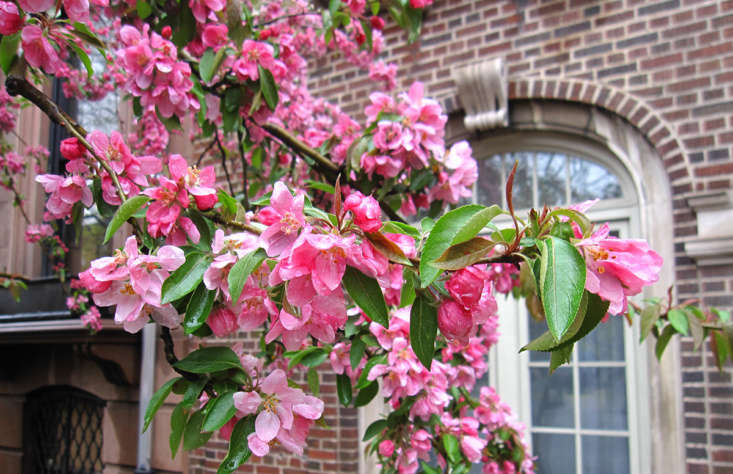Crabapple Tree, Malus
There was a big red crabapple tree in my childhood garden. In spring its tangle of branches overflowed with dark burgundy flowers, cascading over a garden wall. One year my father—a non-gardening, power-sawing weekend warrior—decided to tame that tangle by shearing it into an even line. The line ended where the wall began. When my mother came home and saw it she cried.
My mother, a lifelong gardener, knew the appeal of crabapples lies precisely in that characteristic fretwork of branches, festooned with flowers in spring and rich with leaf color and fruit at the end of the season, and into winter. My dad sheared that crabapple because the way it cascaded over the wall offended his sense of order, which only admitted straight lines and right angles. The tree did not recover its shape before we moved away to another city—but continued to bloom beautifully, ending abruptly at the wall.
This was a lesson to prune crabapples and other trees in keeping with their form. My dad, who died last week, learned to embrace the beauty of curves and natural form. We are arranging a memorial in my mom’s garden, which he loved, and never wanted to leave.
Read on to learn how to grow crabapples, ideal trees for beauty, multi-seasonal bounty, and resilience.
Photography by Marie Viljoen.



I often include crabapple trees in designs for rooftop gardens: smaller trees behave well in containers (not outgrowing them too fast), and they are hardy enough to withstand nippy winds on high floors.
Different species, and hundreds of hybrids and cultivars of the Malus (apple) genus offer gardeners a dizzying array of choice. Among our favorites in the garden are M. floribunda (Japanese flowering crabapple); M. angustifolia (the southern crabapple, which also is native to the Eastern Seaboard), and cultivars such as M. ‘Beverly’ which have pink buds that open to white flowers.

At the peak of their bloom, very few other trees can equal the voluptuously airy appearance of a crabapple. Unlike their rival, the fussy ornamental cherry, crabapple’s spring petals are given a framing boost by emerging foliage.




Cheat Sheet
- Because of some crabapples’ susceptibility to diseases including fire blight, rust, scab and mildew, do some research before buying. Ask your local nursery to recommend cultivars that are resistant to regional health challenges.
- A growers’ chart can guide you to the right tree.
- To extend your season of flowering happiness, plant two to three different crabapples that bloom in sequence.
- The tiny fruit of crabapples is very high in pectin: add crabapples to jams and jellies to reach setting point naturally.

Keep It Alive
- Plant crabapples in full sun (six or more hours a day).
- Crabapples prefer slightly acidic soil; they will not thrive in alkaline soil.
- Crabapples will tolerate heavy and compacted soils as long as they do not have soggy feet.
- Prune any suckers back close to the ground.
- Prune branches lightly and judiciously (no power saws!) in late winter.
- Disinfect pruning tools to minimize the spread of pathogens.
Read more growing tips in Crabapple Trees: A Field Guide to Planting, Care & Design in our curated garden design guides to Trees 101. Read more:
- Back to Africa: At Home in My Mother’s Garden
- 10 Ideas to Steal from Botanical Gardens Around the World
- A Poet’s Garden: Edna St. Vincent Millay at Steepletop









Have a Question or Comment About This Post?
Join the conversation